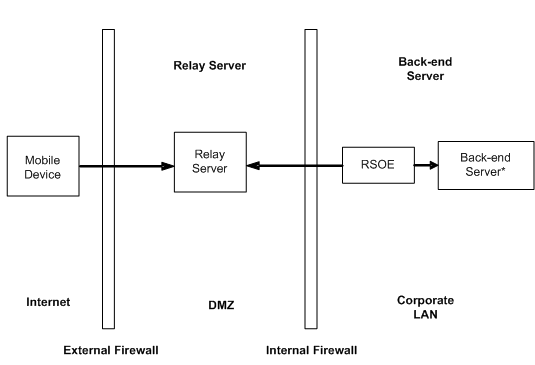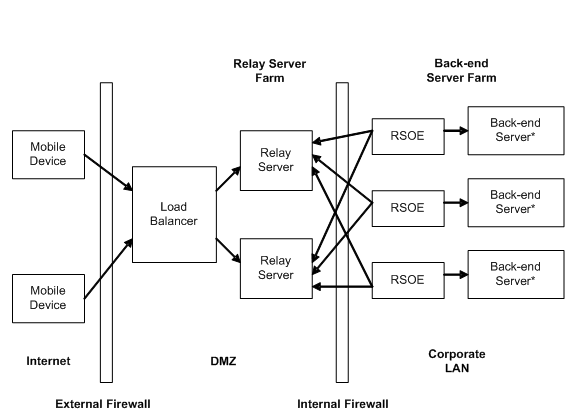A Relay Server deployment consists of the following:
Mobile devices running client applications and services that need to communicate with back-end servers running in a corporate LAN.
Optional load balancer to direct requests from the mobile devices to a group of Relay Servers.
One or more Relay Servers running in the corporate DMZ.
At least one back-end server running in a corporate LAN that is responsible for servicing client requests. The following back-end servers are supported for use with the Relay Server:
Relay Server is tested with specific back-end servers and clients that communicate using well-defined HTTP requests and responses. Deployments that use custom HTTP traffic, including using SQL Anywhere as a Web server, must thoroughly test the traffic to ensure that it works with the Relay Server.
Refer to your license agreement or the SQL Anywhere Components by Platforms page for information about which back-end servers
are supported. See ![[external link]](gif/external.gif) http://www.sybase.com/detail?id=1061806 .
http://www.sybase.com/detail?id=1061806 .
There is usually only one, but there may be several, Relay Server Outbound Enablers (RSOE) per back-end server. The Outbound Enabler manages all communication between a back-end server and the Relay Server farm.
The following diagram shows the Relay Server architecture with a single Relay Server.

Refer to your license agreement or the SQL Anywhere Components by Platforms page for information about which back-end servers
are supported. See ![[external link]](gif/external.gif) http://www.sybase.com/detail?id=1061806 .
http://www.sybase.com/detail?id=1061806 .
The following diagram shows the Relay Server architecture for a more complex system with a Relay Server farm and a back-end server farm.

Refer to your license agreement or the SQL Anywhere Components by Platforms page for information about which back-end servers
are supported. See ![[external link]](gif/external.gif) http://www.sybase.com/detail?id=1061806 .
http://www.sybase.com/detail?id=1061806 .
The Relay Server consists of a set of web extensions, a background process for maintaining state information, and a web server.
Because the Relay Server is a web extension running in a web server, all communication is performed using HTTP or HTTPS. Using HTTP easily integrates with existing corporate firewall configurations and policies. The Relay Server requires that the connection from the corporate LAN to the Relay Server be initiated from inside the corporate LAN. This provides a more secure deployment environment because it does not require inbound connections from the DMZ into the corporate LAN.
The Relay Server contains two web extensions: a client extension and a server extension. The client extension handles client requests made from applications running on mobile devices. The server extension handles requests made by the Outbound Enabler on behalf of a back-end server.
 Shared Memory and Security
Shared Memory and SecurityThe Relay Server farm
Relay Server security
 |
Discuss this page in DocCommentXchange.
|
Copyright © 2012, iAnywhere Solutions, Inc. - SQL Anywhere 12.0.1 |